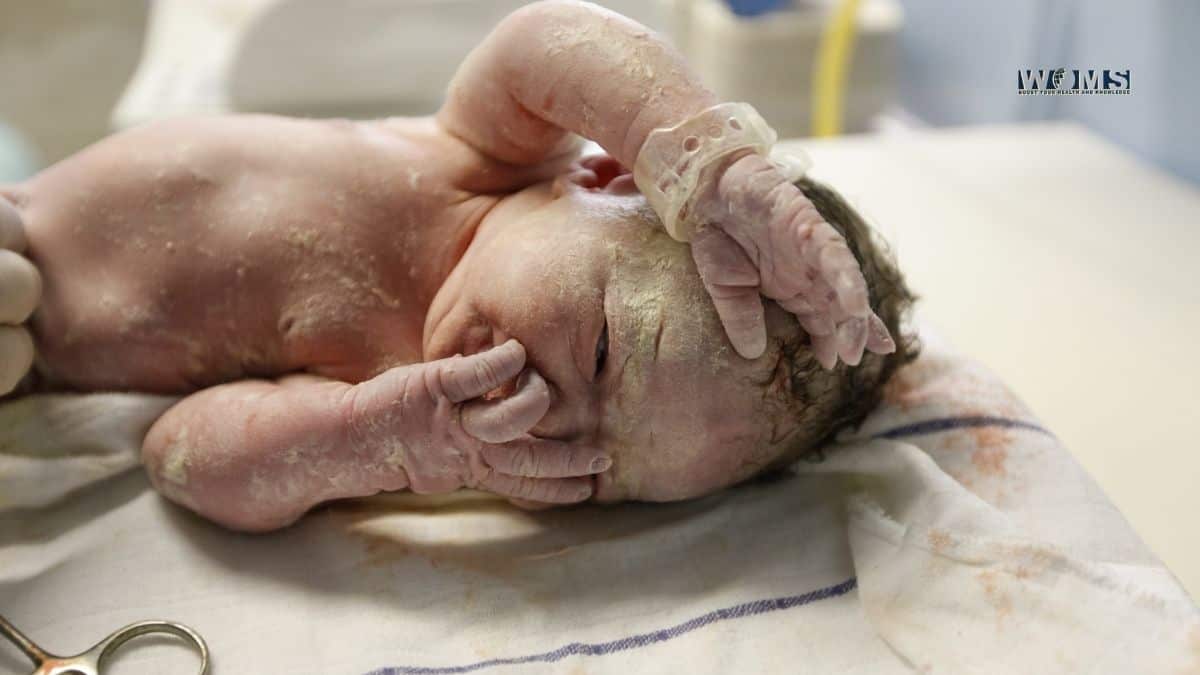Vernix Caseosa: What is It?

Keeping your baby’s skin coated in vernix caseosa is a practice that has been around for centuries. Vernix caseosa is a white, waxy substance that coats the human fetus and provides protection from infection during the first few hours after birth. The practice of keeping your baby’s skin covered in vernix caseosa can help prevent infections, reduce microbial load on the newborn, and provide an anti-oxidant barrier to protect against environmental stressors. In this blog post, we will discuss how you should be practicing this time-honored tradition as well as some other benefits it can have!
However, many healthcare providers believe that it is important for newborns and the benefits outweigh any risks. There are some concerns about whether or not babies having it should be bathed after birth.
Some parents may worry that the vernix caseosa will make it more difficult to bathe their infant. If a baby is born with a thick coating of vernix, there are steps you can take to remove some before bathing your baby.
Alternatively, if this isn’t possible or desired, healthcare professionals have noted no difference in skin condition between babies who were bathed immediately after birth and those who weren’t. In fact, many research studies show that infants whose was not washed had less risk for certain infections than did clean right away, But limited access to water sources can be an issue during natural disasters such as hurricanes where floodwaters cause contamination from sewage systems chemicals which means washing affected.
What is vernix caseosa made of?
The sebaceous glands which are responsible for producing oil in the skin are very active in the vernix caseosa. The sebum that is released lubricates and waterproofs the baby’s skin, helping to protect it from the amniotic fluid. It also contains cholesterol, which may help to keep the baby’s skin healthy after birth.
Why do some babies have no vernix?
Some babies have a thinner one or may not produce any vernix at all. This is more common in premature babies, who often don’t have as much time to mature before they are born. Babies who are overdue may also have a thin coating of vernix caseosa.
Purpose of vernix caseosa
It protects Baby’s skin from bacteria and other environmental factors. The vernix also helps to regulate the baby’s body temperature It is a protective layer that coats the skin of newborn babies. It is composed of sebum, sweat, and cells from the baby’s skin. This coating helps to protect the after birth.
The vernix begins to form in the womb, and it continues to be produced until about six months after birth. Babies who are born prematurely or who have low levels of vernix may be at risk for skin problems.
Benefit and washing of vernix caseosa
The benefits of it are vast and well-documented. It is a natural moisturizer that helps keep the baby’s skin soft and elastic. It also has antibacterial properties, which can help protect against infection. Additionally, it contains enzymes that promote cell growth and wound healing. Finally, it is thought to provide some protection from UV radiation exposure.
Since it is so beneficial, it’s important to make sure it isn’t washed off prematurely. In most cases, the vernix will gradually disappear on its own over the course of a few weeks or months after birth. However, in some cases, it may be necessary to wash it off if it becomes thickened or starts to cause skin problems.
If this is the case, it should be done very gently and only with water. Soap or any other type of cleanser should not be used, as they can strip away the vernix’s natural oils and disrupt its protective properties.
It is important to remember that it is a natural substance that plays an important role in protecting a baby’s delicate skin. When caring for a newborn, it’s best to let nature take its course and avoid washing the vernix off prematurely unless it is necessary. By doing so, you can ensure that your baby enjoys all of the benefits that this unique substance has to offer.
The Practice of Keeping Baby’s Skin Coated in Vernix Caseosa
Since it is so beneficial, it’s important to make sure it isn’t washed off prematurely. In most cases, the vernix will gradually disappear on its own over the course of a few weeks or months after birth. However, in some cases, it may be necessary to wash it off if it becomes thickened or starts to cause skin problems.
If this is the case, it should be done very gently and only with water. Soap or any other type of cleanser should not be used, as they can strip away the vernix’s natural oils and disrupt its protective properties.
It is important to remember that it is a natural substance that plays an important role in protecting a baby’s delicate skin. When caring for a newborn, it’s best to let nature take its course and avoid washing the vernix off prematurely unless it is necessary. By doing so, you can ensure that your baby enjoys all of the benefits that this unique substance has to offer.

Characterization of Vernix Caseosa
It is a white, cheese-like substance that coats the skin of newborns. It is composed of sebum, sweat, and cells from the baby’s skin.
The vernix caseosa serves several important functions:
- It protects the baby’s skin from bacteria and other contaminants.
- It helps keep the baby’s skin hydrated.
- It regulates the temperature of the baby’s skin
It is a white, cheese cheese-like material that coats the skin of newborn babies. It is composed of sebum cells from the baby’s skin, and lanugo (fine hair). They help protect am amniotic fluid urine, which can be corrosive also regulate body temperature prevents loss of moisture from the skin.
The composition of vernix caseosa changes as the baby grows. In late pregnancy, it contains high levels of cholesterol and proteins that help protect against infection. After birth, these drop baby’s immune system develops.
How can vernix caseosa be prevented from being washed off during delivery?
There are a few ways to prevent vernix caseosa from being washed off during delivery. One is to coat the baby’s skin with a layer of petroleum jelly before the water breaks. Another is to apply a liberal amount of vernix caseosa directly to the baby’s skin as soon as he or she is born. Either way, it’s important to make sure that the newborn’s skin stays coated in vernix caseosa until it naturally sheds within the first several days of life.
The benefits of vernix caseosa are numerous and include protection against infection, moisturizing and nourishing the skin, and regulating body temperature. So while there may be some extra work involved in keeping that layer of vernix caseosa intact, the payoff is definitely worth it.
When does Vernix Caseosa appears and dissapears?
The vernix caseosa appears on the baby’s skin at around 36 weeks gestation and begins to disappear after birth. It is most commonly found on the baby’s head, neck, and shoulders. The vernix caseosa helps protect the baby’s skin from the amniotic fluid during pregnancy and serves as a natural moisturizer. After birth, it gradually disappears as the baby’s skin starts to produce its own oils.
This protective coating will eventually slough off over time, but there is no need to worry if some remains on your baby’s skin after he or she is born. In fact, leaving the vernix caseosa on your newborn can actually help keep their skin healthy!
How does it smell?
The vernix caseosa that coats a baby’s skin smells slightly cheesy. This scent is caused by the presence of certain bacteria on the skin that breaks down fat into acids that have a cheesy smell. While this may seem unappealing to some, the cheese-like odor actually helps protect babies’ delicate skin from infection. In fact, studies have shown that newborns with fewer vernix caseosa are more likely to develop infections than those with a thicker coating. So even though it may not be the most appealing thing in the world, don’t forget to keep your baby coated in vernix caseosa! It’s crucial for their protection.
How does vernix caseosa form?
Vernix caseosa coats a baby’s skin in the last few months of gestation. It serves as both a vernacular to prevent infection, and also provides protection against amniotic fluid during labor. The coating appears white or yellowish-white when first formed, but will darken over time.
Vernix is produced by sebaceous glands that are located on the fetus’ skin around week 20 of development. As these hormones develop throughout pregnancy, they secrete oil into fetal hair follicles and onto the skin surface – much like adult apocrine sweat gland secretions (which explains why babies can smell so good!).
This secretion mixes with other substances such as the breakdown products from the chorion villi cells and lanugo hair, and with proteins such as vernix caseosa. By the time a baby is born, these secretions have turned into a thick paste that we know as “vernix.”
How to prevent it before child birth?
Keep skin moist and hydrated. This could be done by using lotions or oils several times a day, especially on the abdomen and chest.
Avoid harsh soaps when you cleanse your body before going to bed at night. It is recommended that women should not use soap directly on their abdomens while pregnant because it can strip away this protective coating from the baby’s skin. Soap can also dry out your vaginal area which leads to yeast infections in some cases, causing discomfort for both mommy and baby during labor!
If you are uncomfortable with skipping soap altogether then simply dilute it with water instead of applying it straight onto the belly region.
Medical uses:
The medical use of vernix caseosa is still being studied, but it is thought that the substance may help to protect a baby’s skin during the birthing process. It is also believed that vernix caseosa helps to regulate a baby’s temperature and protect them from infection.
Some research has shown that babies who are coated in vernix caseosa have lower rates of respiratory problems after birth. Additionally, vernix caseosa may help to improve a baby’s development in the early weeks and months after birth. More research is needed in this area, but there is potential for vernix caseosa to play an important role in newborn care.
In some cases, doctors will remove the vernix caseosa from a baby’s skin soon after birth. This is often done if the baby has to be admitted to the neonatal intensive care unit (NICU), as vernix caseosa can interfere with medical equipment. However, there is growing evidence that suggests leaving the vernix on a baby’s skin may be beneficial, and many hospitals are now adopting policies that allow newborns to retain their natural coating for at least a few hours after birth.
What is it made up?
Vernix caseosa is a thick, white substance that coats the skin of newborn babies. It is composed of oils, cholesterol, water, and proteins, and plays an important role in protecting a baby’s delicate skin during the birthing process. Vernix caseosa also helps to regulate a baby’s temperature and protect them from infection.
In some cases, doctors will remove the vernix caseosa from a baby’s skin soon after birth, but there is growing evidence that suggests leaving the vernix on a baby’s skin may be beneficial. Many hospitals are now adopting policies that allow newborns to retain their natural coating for at least a few hours after birth.
The practice of keeping a baby’s skin coated in vernix caseosa has many potential benefits, and more research is needed to determine exactly how this substance affects newborn development. However, it seems clear that vernix caseosa plays an important role in protecting a baby’s delicate skin during the birthing process and in the days and weeks after birth.
What are the functions of Vernix caseosa?
Vernix caseosa performs a variety of functions during pregnancy and after birth. In addition, this layer helps to protect your baby from various environmental changes after birth. Let us highlight the benefits of this layer.
Lubrication
Vernix caseosa is a creamy substance because of its lipid content. It helps to provide lubrication while passing through the birth canal. In addition, it also lowers friction forces during the delivery process. In this way, it helps in the easy delivery of your newborn.
Antimicrobial protection
Infants have very weak immune systems and are vulnerable to multiple diseases and microorganisms. Vernix caseosa possesses antimicrobial properties to protect your child from diseases after birth. In addition, vernix caseosa contains antioxidants to prevent your baby from infectious and inflammatory processes.
Maintain body temperature
During pregnancy, the mother’s body plays a main role in regulating the baby’s temperature. After birth, it takes some time for the baby to maintain its body temperature. Vernix caseosa helps to stabilize the body temperature. In addition, it lowers the evaporative loss after birth. In this way, it helps to regulate the baby’s body temperature.
Wound healing capacity
Vernix caseosa helps to increase skin metabolism by increasing glucose use and lactate production. This feature helps in barrier formation and regeneration. In this way, vernix caseosa possesses healing capacity.
Moisturizing properties
Vernix caseosa also provides soft and smoother skin after delivery. This creamy substance is a moisturizer for newborns to protect them from dryness and cracking.
What should be done if it appears on a baby’s skin?
If you notice vernix caseosa on your baby’s skin, do not worry. This is a natural occurrence and is nothing to be concerned about. In most cases, there is no need to take any special action. However, if the vernix seems to be thick or clumpy, you can gently wipe it away with a damp cloth. Make sure to dry your baby’s skin thoroughly afterward. If the vernix appears to be excessive or causing discomfort, speak with your doctor for advice.
Some babies are born without any vernix caseosa at all, while others have quite a bit of it coating their skin. There is no right or amount – it simply depends on the individual baby. If your baby is born with a lot of vernix, it will gradually disappear over the course of a few days as the skin adjusts to life outside the womb. However, if your baby is not born with much vernix, don’t worry – it will slowly accumulate over time.
There are no known benefits of vernix caseosa for babies, but there are some potential benefits for mothers. It has been hypothesized that vernix may help protect against infection and reduce the risk of developing allergies later in life. More research is needed to confirm these claims, but it’s an interesting area of study nonetheless.
Also read: Pregnant Belly Progression
Advice to mother of an infant that has vernix caseosa on skin:
The vernix caseosa is a natural moisturizer for the baby’s skin. It is important to keep the baby’s skin coated in this substance to protect it from drying out. You can do this by gently massaging the vernix into the baby’s skin after each bath. This will help keep the baby’s skin healthy and protected.
If you have any questions about the vernix caseosa, please consult your pediatrician. They can provide you with more information on this beneficial substance and how best to care for your infant’s delicate skin.
Conclusion:
Babies are born with a natural moisturizing layer of vernix caseosa. Vernix caseosa helps to provide a variety of benefits for the health of the newborn. Nurses usually separate newborns from their mothers after birth for proper testing and bathing. Baby testing is an important part after birth. But, bathing is not necessary right after birth.
Bath can remove the vernix caseosa layer besides removing blood and amniotic fluid. So, you can request a nurse to only clean the blood and amniotic fluid with any soft cloth. It may protect the vernix caseosa layer for some time. Usually, it is recommended to leave that layer for about 24 to 48 hours.
FAQS:
Is it normal to have Vernix caseosa in the newborn baby?
Yes, it is normal to have Vernix caseosa in the newborn. It is mainly seen in the baby born after a full term.
What is it made up of?
Vernix caseosa is made up of water, lipids, and proteins and has a creamy and greasy texture to it.
How long should we leave the vernix caseosa layer on the newborn?
The World Health Organization suggests leaving the layer for at least 6 hours. But, ideally, it is good to leave that layer for almost 24 hours to get proper benefits.
Is there any risk associated with leaving the vernix caseosa layer after birth?
Usually, there are no risks associated with the vernix caseosa layer. But there are some rare exceptions. Babies born with meconium staining need to bathe immediately after birth. These may cause bacterial respiratory infections in newborns.
Mothers with HIV or Hepatitis positive may need to bathe their babies as soon as possible to prevent any disease transmission.




